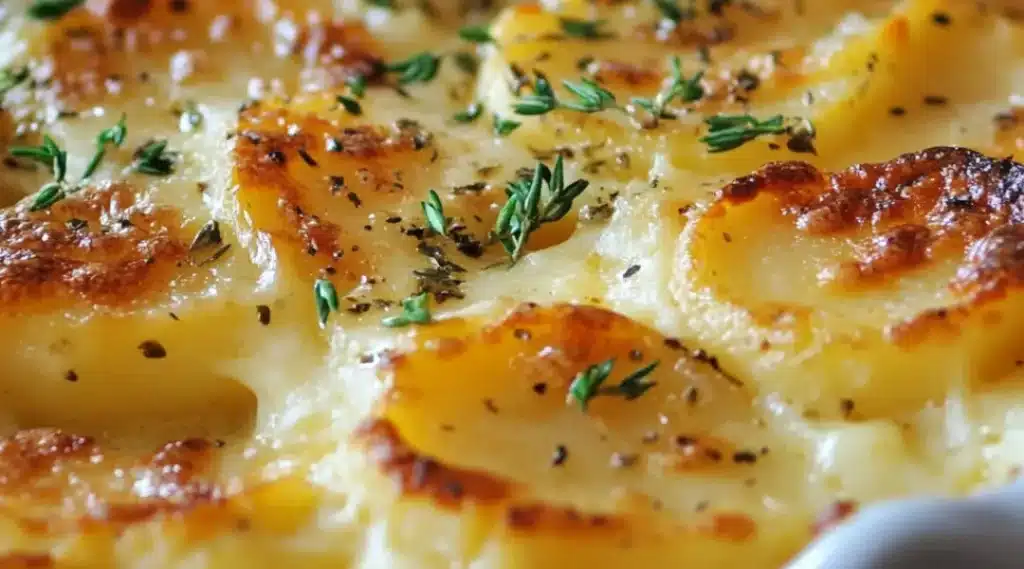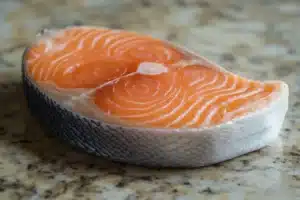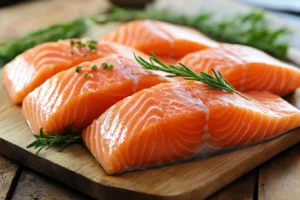Scalloped potatoes and au gratin potatoes are classic comfort foods. These dishes often grace dinner tables, especially during holidays. At first glance, they seem similar. Both involve sliced potatoes baked in a creamy sauce. However, distinct differences set them apart in preparation and flavor. Understanding these differences enhances your cooking knowledge. It also helps you choose the perfect dish for your next gathering.

Introduction to Scalloped and Gratin Potatoes
Both scalloped potatoes and au gratin potatoes originated in French cuisine. American kitchens have embraced them for their rich flavors and textures. These dishes have become staples for special occasions. They offer a warm, satisfying side dish that complements many main courses. Despite their popularity, many people use the terms interchangeably. Yet, subtle differences make each dish unique.
For a deeper understanding, explore this Scalloped Potatoes vs. Au Gratin Potatoes guide. Bon Appétit also provides insight on the Difference Between Scalloped and Au Gratin Potatoes.
Historical Background
Origins of Scalloped Potatoes
The term scalloped likely came from “collop,” an Old English word. It means slices of meat or fish. Cooks sliced these thinly and baked them. Over time, this method adapted to include vegetables, especially potatoes. Scalloped potatoes gained popularity in Europe. They were particularly popular in France and England. The technique of layering thin potato slices and baking them in cream became a culinary staple.
Scalloped potatoes evolved into classic comfort food in America. European immigrants brought the recipe over. Traditionally, families served it with ham or roast meats. The dish was valued for its simplicity and versatility.
Origins of Au Gratin Potatoes
Au gratin potatoes have roots in French cuisine. They come from the “gratin” technique. This involves baking a dish with a crispy, golden crust. The word “gratin” comes from the French verb “gratter,” meaning to scrape. It refers to how the dish is often scraped from the pan to get the crunchy bits.
Originally, chefs used the gratin technique for vegetables. Later, they adapted it to include potatoes. Adding cheese made the dish richer and more indulgent. The popularity of au gratin potatoes spread across Europe. Eventually, it became a favorite in the United States. Today, it is often served at holiday meals and special occasions.
Understanding the Basics
What Are Scalloped Potatoes?
Scalloped potatoes are made by layering thinly sliced potatoes in a baking dish. The potatoes are then covered with a cream-based sauce. This sauce usually consists of milk, heavy cream, or both. It is often flavored with thyme, garlic, and onions. The dish bakes until the potatoes become tender. The sauce thickens into a creamy, velvety consistency.
Modern variations might include cheese. However, traditional scalloped potatoes focus on the creamy sauce. This allows the natural potato flavors to stand out. The dish is rich but light enough to serve with various main courses.
What Are Au Gratin Potatoes?
Au gratin potatoes are a richer version of scalloped potatoes. The key difference is the addition of cheese. The term “au gratin” refers to a dish topped with cheese or breadcrumbs. It is then baked or broiled until crispy and golden. This technique gives au gratin potatoes their distinct texture and flavor.
To prepare au gratin potatoes, thinly slice the potatoes. Layer them in a baking dish with cheese, like Gruyere, cheddar, or Parmesan. Top the dish with more cheese and breadcrumbs. Bake until the top is golden and crispy. The cheese melts into the potatoes, creating a rich, creamy interior with a satisfying crunch.
Similarities Between Scalloped and Au Gratin Potatoes
Despite their differences, scalloped potatoes and au gratin potatoes share similarities:
Slicing Techniques
Both dishes involve thinly slicing potatoes into rounds. A mandoline or a sharp knife works best for even slices. Thin slices ensure even cooking and flavor absorption. Uniform slices allow for consistent cooking and a harmonious blend of flavors and textures.
Baking Method
Both scalloped and au gratin potatoes bake in a casserole dish. This method allows the potatoes to cook in a creamy or cheesy sauce until tender. The baking process also develops a golden crust on top, adding flavor and texture. The casserole dish helps retain heat, ensuring even cooking and proper sauce thickening.
Creamy Base
Both dishes use a cream or milk-based sauce to achieve a rich, creamy texture. The sauce in scalloped potatoes is simple, while au gratin potatoes include cheese. This creamy base gives these dishes their signature comfort food appeal. The sauce adds flavor and binds the potato layers together, creating a cohesive dish that satisfies.
Flavor Profile and Texture
Both dishes are known for their rich and creamy texture. They are popular choices for holiday meals and special occasions. The main flavor difference is the use of cheese in au gratin potatoes. Cheese adds distinct richness and depth. In contrast, scalloped potatoes offer a more subtle, creamy flavor. This allows the natural taste of the potatoes to shine through.
Differences Between Scalloped and Au Gratin Potatoes
While scalloped and au gratin potatoes share many similarities, key differences set them apart:
Slicing Thickness
One key difference is the thickness of the potato slices:
- Thicker Slices for Scalloped Potatoes: Scalloped potatoes have thicker slices, resulting in a heartier texture. This thickness allows the potatoes to hold up better in the cream sauce. The thicker slices take longer to cook. However, the result is a dish with distinct and flavorful layers.
- Thinner Slices for Au Gratin Potatoes: Au gratin potatoes have thinner slices, allowing cheese and cream to permeate more deeply. This creates a more delicate and rich dish. Each slice of potato is infused with the flavors of cheese and sauce. The thinner slices also cook quickly, allowing the cheese to melt and create a creamy dish.
Cheese Usage
Cheese usage is another significant difference:
- Cheese in Au Gratin Potatoes: Au gratin potatoes include cheese inside and on top. This creates a rich, cheesy flavor that distinguishes them from scalloped potatoes. The cheese adds flavor, thickens the sauce, and binds the layers. Common cheeses include Gruyere, cheddar, and Parmesan.
- No Cheese in Traditional Scalloped Potatoes: Traditional scalloped potatoes do not contain cheese. The focus is on the creamy sauce made from milk or cream. This makes the dish lighter, with a pronounced potato flavor. While modern recipes may include cheese, the traditional version is simpler, allowing the natural flavors of the potatoes and cream to stand out.
Breadcrumbs and Toppings
The toppings used in each dish also differ:
- Breadcrumb Topping in Au Gratin: Au gratin potatoes often feature a breadcrumb and cheese topping. This bakes until golden and crispy, adding a crunchy texture. The breadcrumbs absorb excess moisture from the sauce, creating a dish that balances creaminess and crispiness.
- Scalloped Potatoes Without Toppings: Scalloped potatoes generally do not include breadcrumbs. This results in a softer top layer. The focus remains on the creaminess of the sauce and the tenderness of the potatoes. Some variations may include herbs or paprika for added flavor and color.
Regional Variations and Modern Twists
Variations Across Regions
Both dishes have evolved, with regional variations adding unique twists:
- French Origins and American Adaptations: Both dishes originated in French cuisine. However, American adaptations introduced new ingredients and techniques. In France, gratin dishes often feature various vegetables, including potatoes, typically topped with Gruyere cheese. In the U.S., cheddar cheese is common in au gratin potatoes, reflecting a preference for bolder flavors. Scalloped potatoes, on the other hand, have remained closer to their traditional roots. They are often prepared with cream, butter, and simple seasonings.
- Regional Preferences: In some U.S. regions, scalloped potatoes are more popular, particularly in the South. They are often served with ham or pork dishes. In contrast, au gratin potatoes might be preferred in regions where richer, cheesier dishes are favored, such as the Midwest. The choice between the two dishes often comes down to personal preference and family traditions.
Modern Takes on Scalloped and Au Gratin Potatoes
Today, chefs and home cooks experiment with these classic dishes, adding gourmet ingredients and creating new variations:
- Gourmet Ingredients: Some modern versions of au gratin potatoes include gourmet cheeses like Gruyere, blue cheese, or goat cheese. These cheeses add a unique flavor profile, making the dish more sophisticated. Toppings like pancetta, truffle oil, or caramelized onions enhance the flavor and presentation.
- Vegetarian and Vegan Versions: Both dishes can be adapted for vegetarian or vegan diets. Non-dairy milk and vegan cheese can replace traditional dairy ingredients, making the dishes suitable for those with dietary restrictions. Vegan versions might incorporate nutritional yeast to add a cheesy flavor without using actual cheese. Additionally, vegetables like spinach, mushrooms, or leeks can be added to both scalloped and au gratin potatoes to create a more complex and nutritious dish.
Frequently Asked Questions (FAQs)
To clarify any remaining questions, here are some
common FAQs about scalloped and au gratin potatoes:
What is the origin of scalloped potatoes?
- Scalloped potatoes have roots in European cuisine, particularly in France and England. The term “scalloped” refers to slicing the potatoes and baking them in a sauce.
Can au gratin potatoes be made without cheese?
- While traditional au gratin potatoes include cheese, you can make a version without it. The dish would then resemble scalloped potatoes without the cheesy crust. If you prefer a less cheesy dish but want a crispy topping, use breadcrumbs and a light sprinkling of Parmesan.
What’s the best type of potato to use for these dishes?
- Yukon Gold and Russet potatoes are popular choices for both scalloped and au gratin potatoes. Yukon Gold potatoes have a naturally creamy texture. Russets are more starchy and can create a fluffier dish.
Can I prepare these dishes ahead of time?
- Yes, both dishes can be assembled ahead of time and baked just before serving. Prepare the dish, cover it with foil, and refrigerate until you’re ready to bake. When ready, bake as directed, adding a few extra minutes if the dish has been refrigerated.
How do I prevent the sauce from curdling?
- To prevent curdling, use full-fat dairy products and avoid baking at too high a temperature. Gently heat the cream before pouring it over the potatoes to help prevent curdling. If the sauce separates during baking, reduce the oven temperature or add a small amount of flour or cornstarch to stabilize it.
Conclusion and Final Thoughts
In conclusion, while scalloped potatoes and au gratin potatoes share many similarities, their differences are in the details. Scalloped potatoes focus on the creamy sauce, allowing the natural flavors of the potatoes to shine through. Au gratin potatoes are richer and cheesier, with a crispy breadcrumb topping that adds texture and depth. Both dishes have their unique appeal, and the choice between them often comes down to personal preference and the occasion.
Whether you prefer the subtlety of scalloped potatoes or the indulgence of au gratin, both dishes are sure to be a hit at your next dinner party or holiday gathering. With their rich flavors and comforting textures, they are the perfect side dishes to complement any main course, from roast beef to ham to poultry.
Try making both and see which one you and your guests prefer. With their rich flavors, creamy textures, and potential for endless variations, both scalloped and au gratin potatoes offer a world of culinary possibilities that are sure to delight and satisfy.


